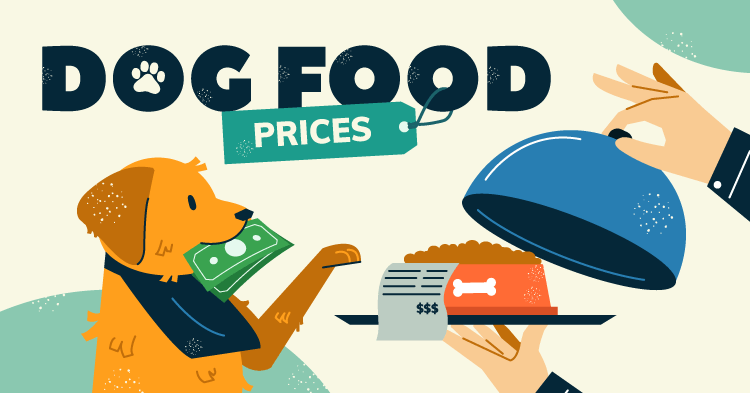From toys and puppy classes to veterinary bills and insurance, owning a dog is by no means cheap, with one study estimating that the lifetime cost of a dog can reach up to $55,000. But no doubt the biggest expense of all on a day-to-day basis is making sure your canine companion is fed.
In times gone by, pets were usually fed with scraps from the dinner table, with only the rich upper classes capable of preparing dedicated meals for their furry friends. Nowadays, however, research has shown that over 40% of owners prioritize giving their pets healthy food over themselves, reflected in the wide range of delicious and nutritious kibble on store shelves the world over.
You don’t even have to go out to get dog food, with a host of services offering to deliver meals tailored to your dog’s specific requirements straight to your door, making for a global market worth a staggering $1.8 billion. But just how much does feeding one dog actually cost in real terms? And where in the world is it the most and least expensive to buy food for man’s best friend?
CashNetUSA went in search of the cost of dog food in 97 countries. Read on to explore our findings.
What We Did
For each country in our analysis, we found the price of the cheapest dry dog food from local supermarkets or — where local supermarkets didn’t offer that information — the price offered by an international supermarket that would deliver to that country. Using guidelines from PetMD, we then calculated the equivalent annual cost of feeding a medium-sized (40 lbs) dog 540 grams of dry food each day. To find out how affordable feeding a dog is in each country, we compared a country’s yearly dog food cost to its national net income per capita.
Key Findings
- The annual cost of feeding a dog in Japan is $2,056.88 — the most expensive of any country in the world.
- On the other end of the scale is Botswana, where feeding a dog for one year costs only $163.59.
- The U.S. is one of the most affordable countries in which to buy dog food — a year’s supply costs only 1.62% of the national net income per capita.
- But out of 97 countries, dog food is the most affordable in Ireland, where the annual cost is just 0.72% of the national net income per capita.
The Cost of Feeding a Dog in Every Country
Dogs are by far the most popular pets in the world, with the number of pet dogs worldwide estimated at 471 million. Every owner has their preferred way of feeding their canine companions — with some choosing particularly gourmet fare — but while local brands differ, the most common types of dog food on store shelves are dry kibble and wet food.
Our map below reveals the average cost of an annual supply of dry dog food in 97 countries. In the United States, home to more pet dogs than any other country in the world, the cost of feeding a dog is $865.50 a year. Compared to countries like Hungary ($246.38) — where more than half of households own a dog — the U.S. is placed closer to the more expensive end of the scale.
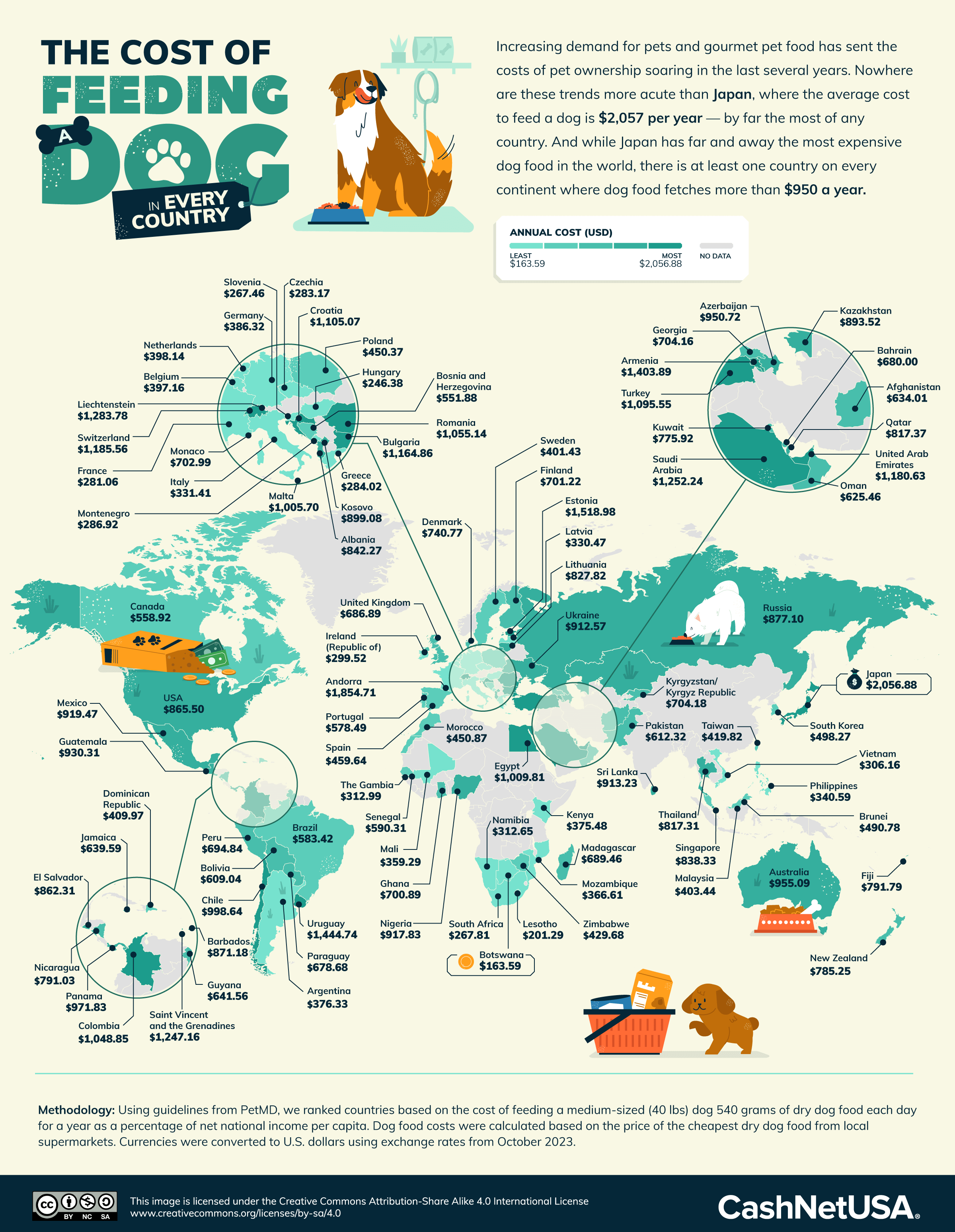
Click to open the map in full size
Japan is the most expensive country in the world in which to feed a dog overall; the average annual cost of dog food is a staggering $2,056.88. Here, pet ownership is actually on the decline, attributable to a variety of factors, including regulations that affect breeders, an aging population that the government discourages from homing dogs and unsuitable home environments. Likely not helping matters is that 2022 saw a sizable increase in the cost of pet food.
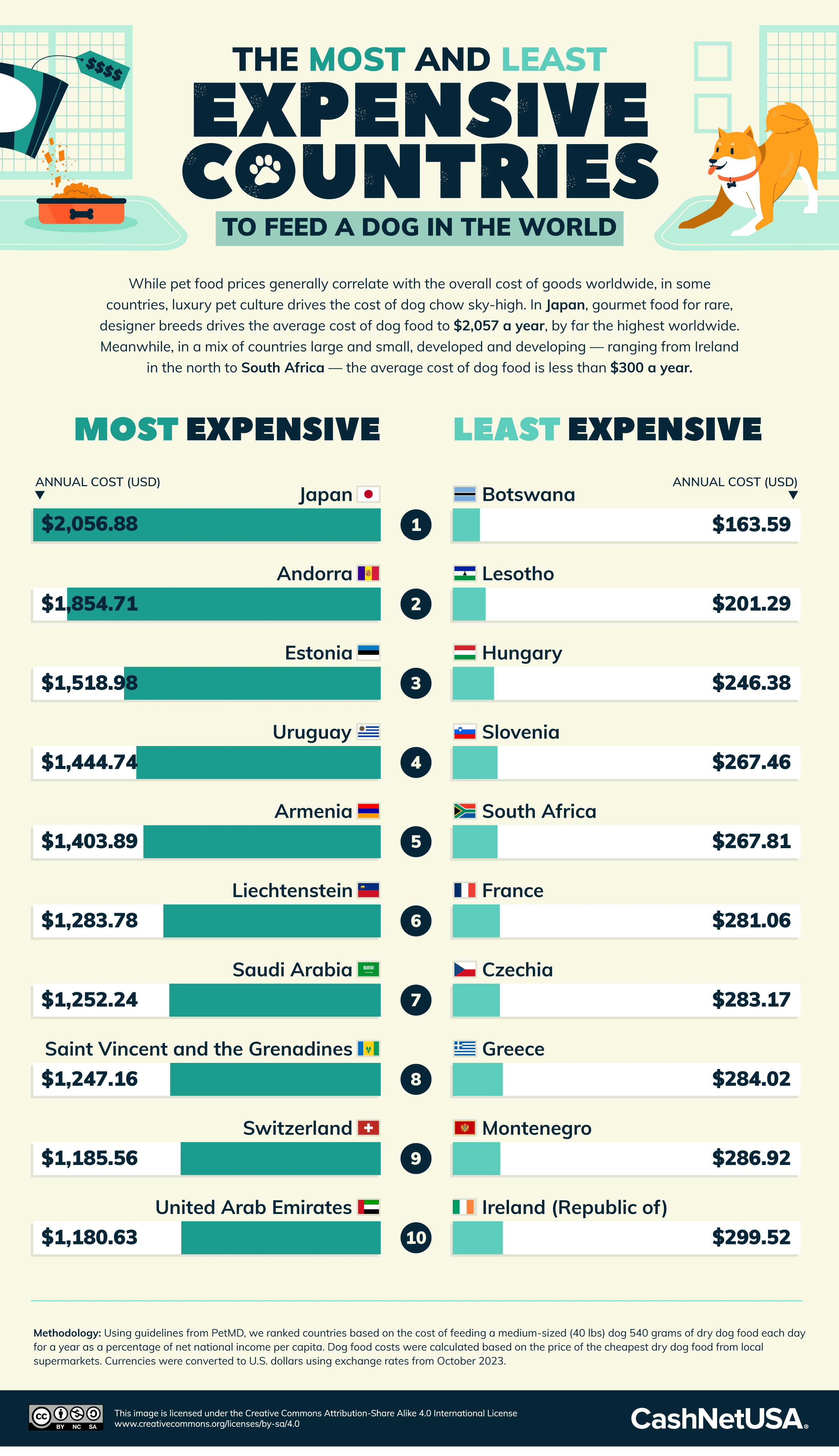
Click here to see the image in full size
Botswana is the least expensive country in which to feed a dog (a year’s supply of food costs just $163.59). Perhaps the cheap price is down to less-than-ideal ingredients; according to one local entrepreneur: “Most retail brands in Botswana and around Africa use basic formulae often resulting in dogs suffering from inflamed skin, and increased scratching caused by [an] imbalance in levels of Omega 3 and 6 along with insufficient levels of essential fatty acids like DHA and FPA.”
The Affordability of Feeding a Dog in Every Country
Another factor that potential dog owners need to consider before bringing home a hound is whether they can afford dog food. Ireland comes top in this respect: here, a year’s supply of dog food costs just 0.72% of the national net income per capita. Not only is Ireland one of the wealthiest nations in the OECD, but it’s home to a variety of pet food brands, including Irish Dog Foods and C&D Foods, one of Europe’s largest manufacturers of pet foods.
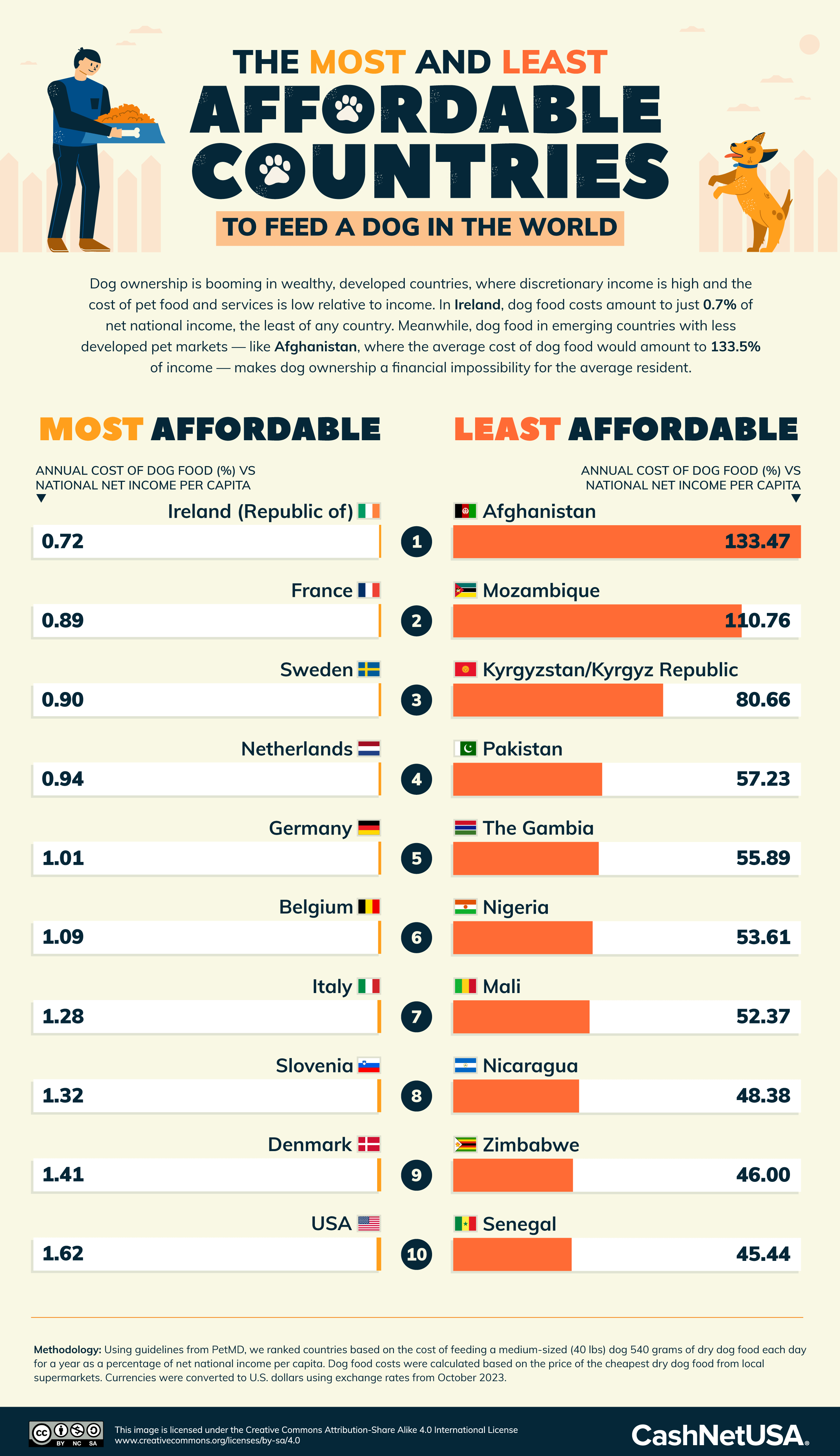
Click here to see the image in full size
Meanwhile, Afghanistan ranks as the least affordable country in which to feed a dog, with an annual supply of dry food costing well over the national net income per capita (133.47%). According to the Afghanistan German Shepherd Dogs Club — the only licensed dog food shop in the country — most citizens feed their dogs “raw meat, rice, bread, beans, nuts, bones and oily food” instead of branded food. This shop has to import food from Europe and Turkey, no doubt inflating the cost.
St. Vincent and the Grenadines is the Most Expensive Country in North America for Dog Food
In Saint Vincent and the Grenadines, the cost of a year’s supply of dog food comes to an astonishing $1,247.16. That’s more than any other country in North America and 44% more expensive than the U.S. As an island nation, it’s likely because the cost of importing food is high. According to one study, dogs in Caribbean countries are traditionally considered “low maintenance,” with households often feeding their pets leftovers instead of branded food.
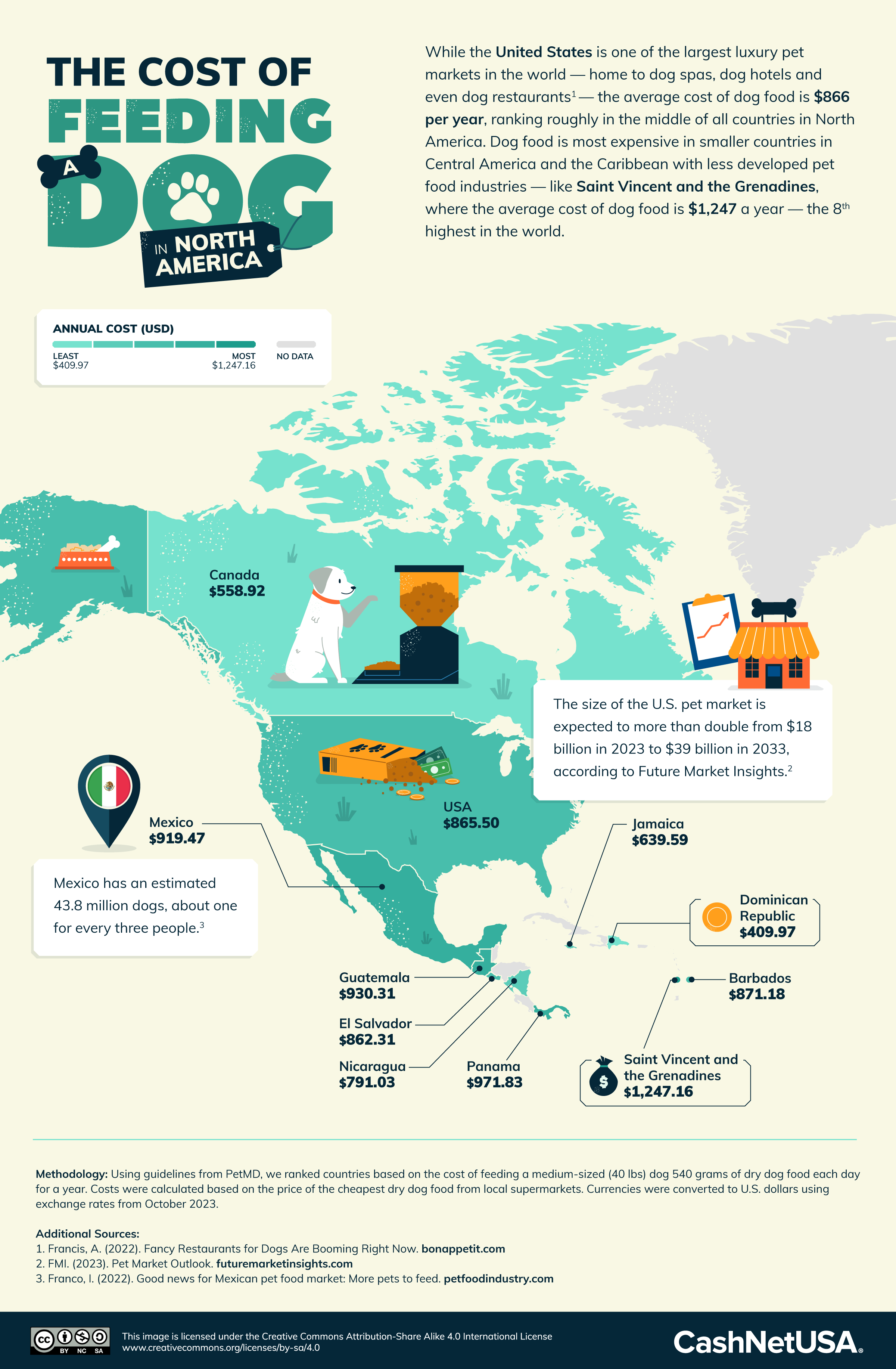
Click here to see the image in full size
The U.S. ranks sixth ($865.50), where dry dog food is more expensive than any other type of dog or cat food. While Canada is the second-cheapest country on the continent ($558.92), soaring pet food prices have seen citizens go hungry to afford to feed their pets.
Feeding a Dog in Uruguay is More Expensive Than Anywhere Else in South America
In South America, Uruguay ranks as the priciest country on the continent in which to feed a dog, with an annual supply of dog food carrying a price tag of $1,444.74. Import costs of specialty brands are one factor behind high local costs. According to an expat forum, canned dog food is a rare sight on store shelves. “Most people buy bones in the supermarket and add either sweet potatoes or rice,” advises a user. Colombia ($1,048.85) and Chile ($998.64) rank in second and third place, respectively.
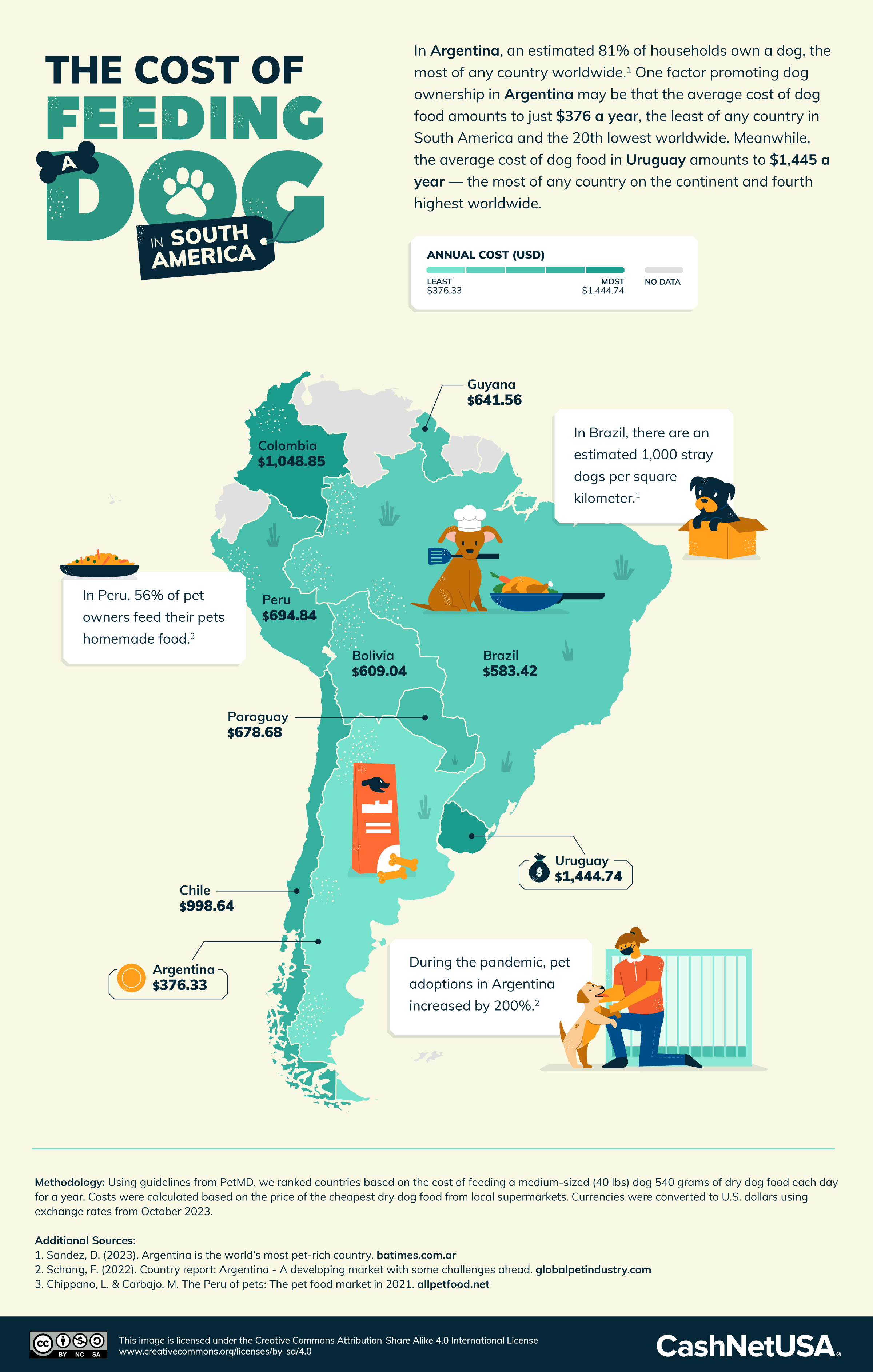
Click here to see the image in full size
Brazil, meanwhile, ranks close to the cheapest ($583.42) end of the scale. Argentina is the cheapest overall ($376.33), likely because — as the biggest pet food exporter on the continent — dog food is fairly easy (and therefore cheap) to come by locally.
Andorra Leads Ranking of the Most Expensive Countries in Europe for Dog Food
As the 16th-smallest country in the world, what Andorra lacks in size it makes up for in the cost of dog food. Here, a year’s supply costs $1,854.71 — more than any other European country, including Switzerland ($1,185.56) and Monaco ($702.99), two of the most expensive countries in the world to live in. In Germany, home to the highest dog population in the European Union, the annual cost of feeding a dog is placed on the cheaper end of the scale at $386.32.
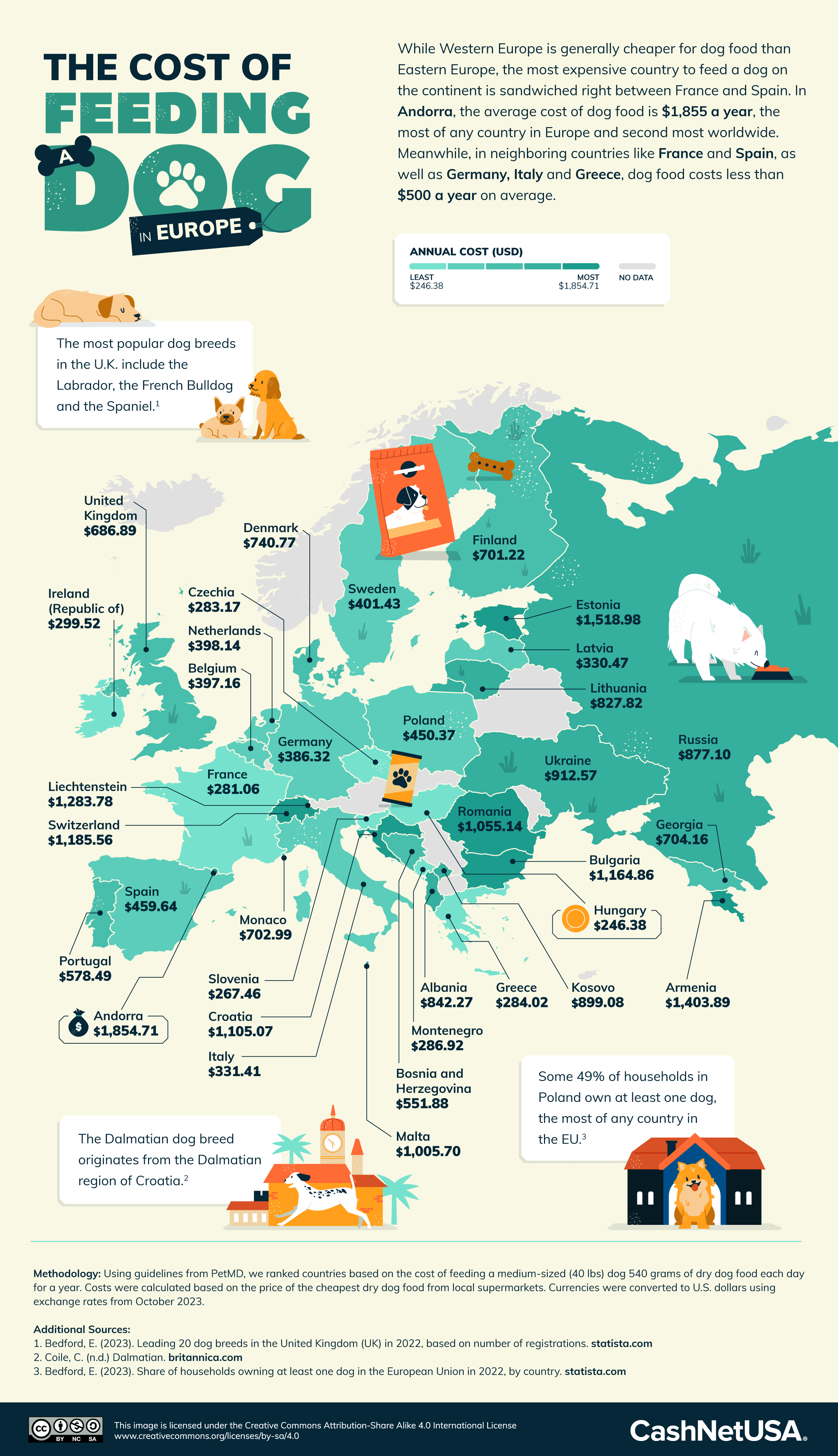
Click here to see the image in full size
The United Kingdom ranks somewhere in the middle ($686.89), a country second only to the U.S. when it comes to pet food market revenue.
Japan and Australia Among the Most Expensive Countries in Asia and Oceania to Feed a Dog
Japan, by far, ranks as the most expensive country in Asia and Oceania in which to buy a year’s supply of dog food ($2,056.88). After that comes Australia ($955.09), where a tripling in freight costs has seen the cost of pet food rise to an “astronomically” high level. In the meantime, small, rural pet food businesses are breaking into the local market. Sri Lanka ($913.23), Singapore ($838.33) and Thailand ($817.31) rank after that.
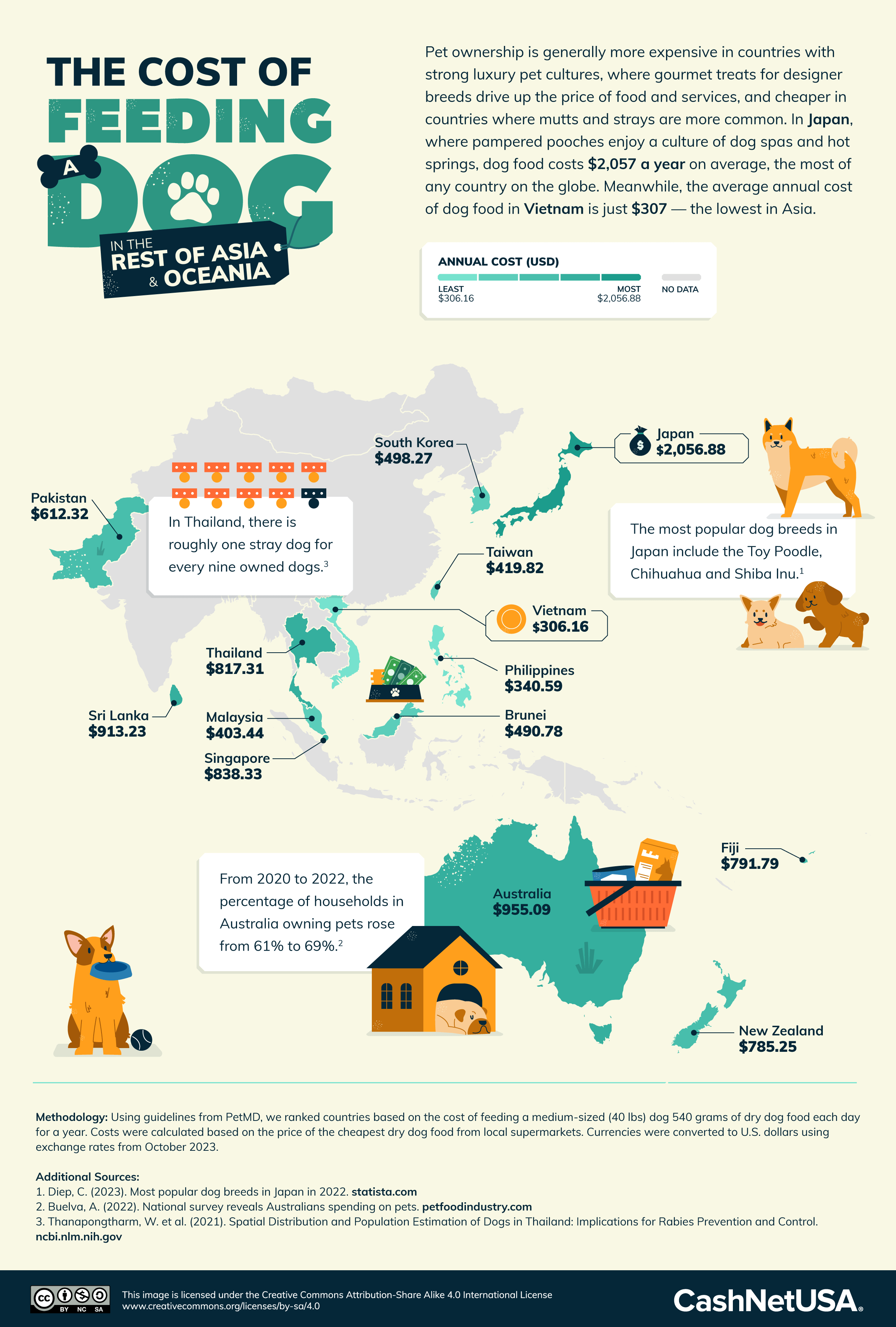
Click here to see the image in full size
New Zealand also places closer to the more expensive end of the scale ($785.25). Here, inflation in the cost of pet goods has seen more and more dogs surrendered to animal shelters in recent years.
Dog Food in Saudi Arabia Costs More Than Anywhere Else in the Middle East and Central Asia
In Saudi Arabia, a year’s supply of dog food costs more ($1,252.24) than anywhere else in the Middle East and Central Asia. Strict laws here dictate that dogs are only allowed to be kept for hunting, guarding or seeing-eye purposes, so perhaps a lack of a market for dog food drives up costs. Turkey ranks as the third-priciest country ($1,095.55), where, in recent years, the volatility in the exchange rate and an 18% VAT rate application on pet food has seen prices soar.
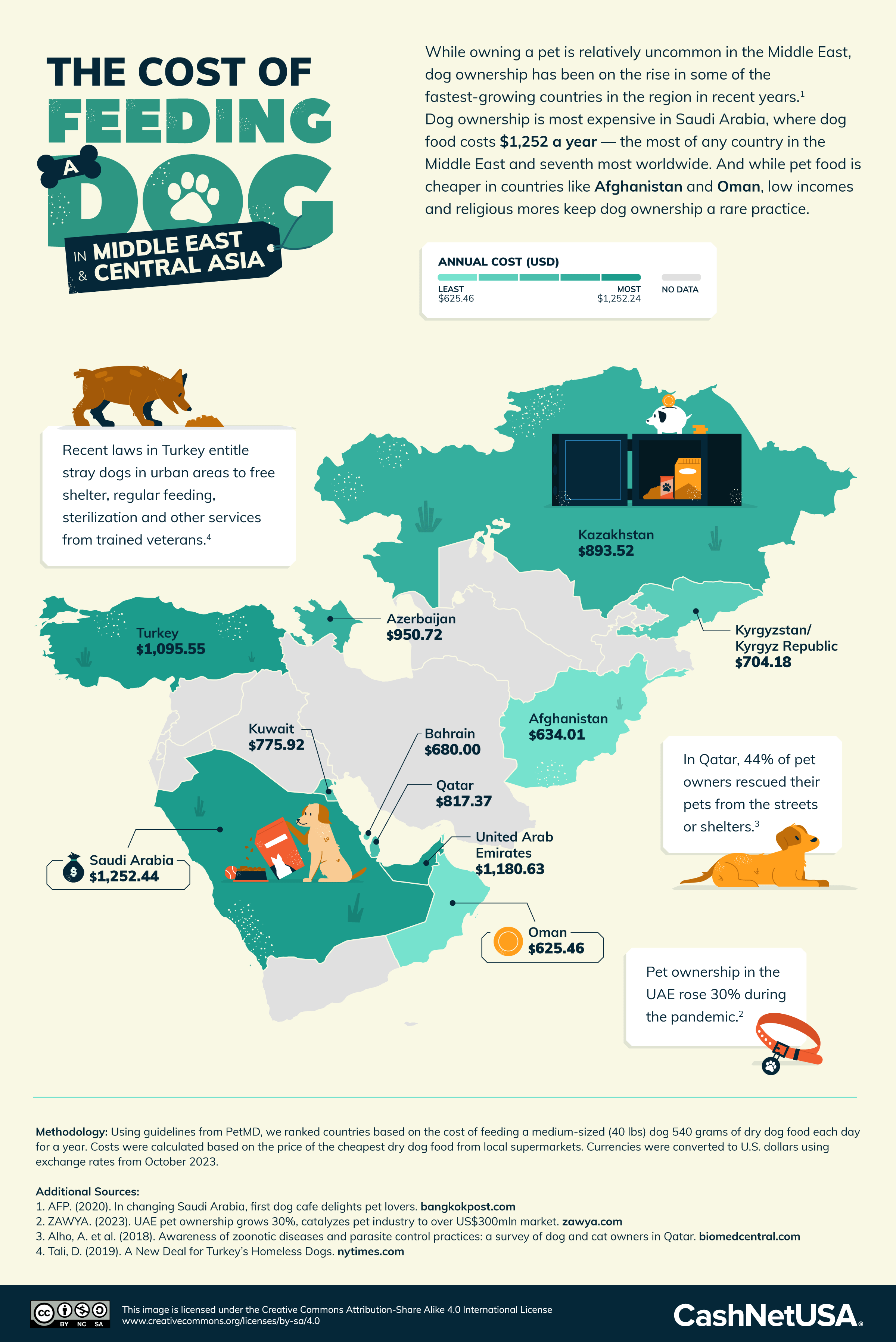
Click here to see the image in full size
Meanwhile, Oman ranks as the cheapest country on the continent ($625.46), alongside Afghanistan ($634.01), Bahrain ($680.00) and Kyrgyzstan ($704.18).
In Africa, Egypt is the Priciest Country in Which to Feed a Dog
Various dog breeds, including the Rhodesian Ridgeback and Basenji, originate from Africa. But how much does the cost of feeding a canine companion vary from country to country on the continent? Egypt ranks as the most expensive by far, a country where a year’s supply of dog food will set you back $1,009.81 on average.
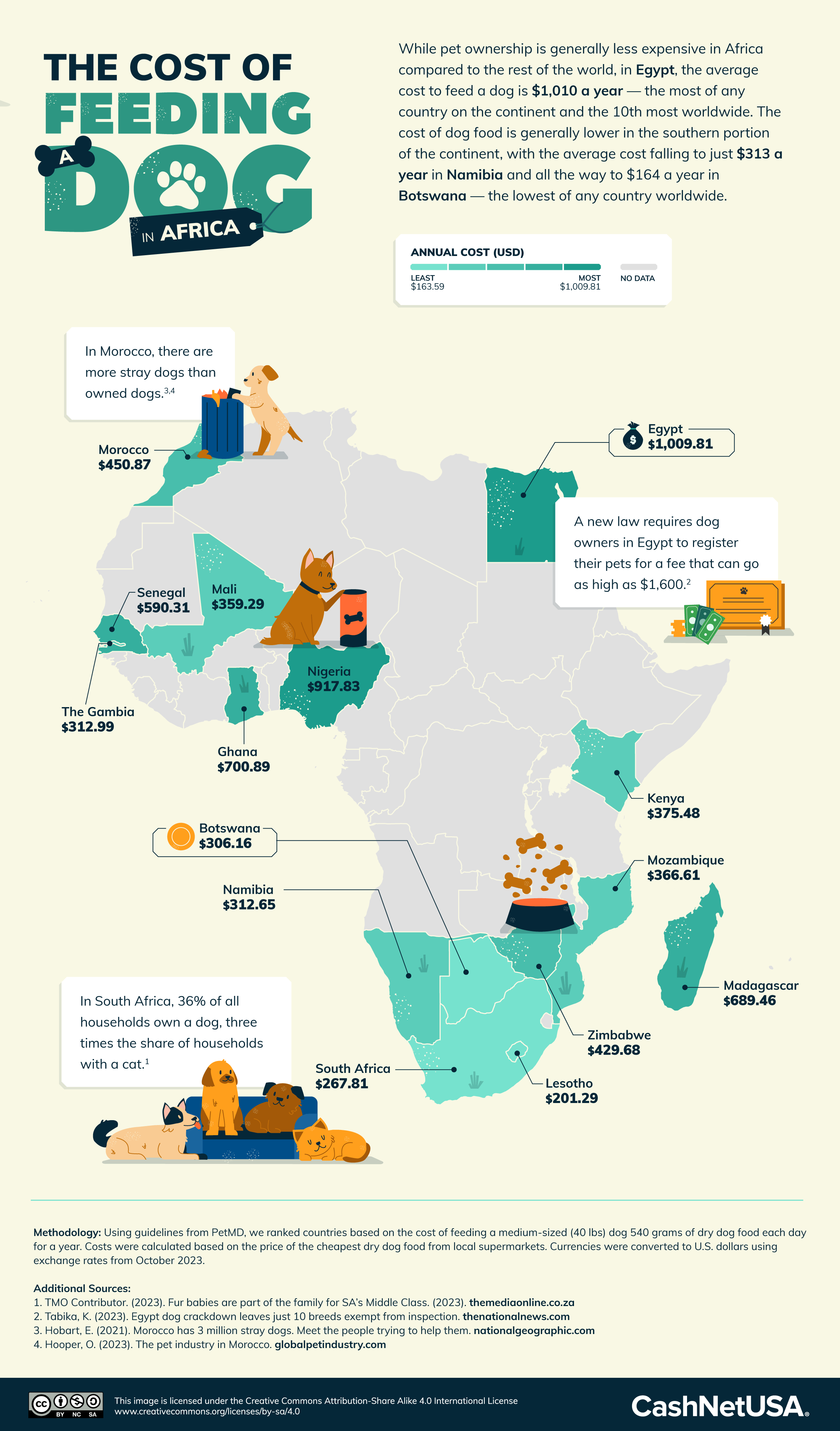
Click here to see the image in full size
Meanwhile, South Africa is one of the least expensive countries in which to feed a dog, with a year’s supply costing just $267.81. Dogs are a popular pet here, with over a third of adults owning one.
Four Healthy Additions You Can Make to Your Dog’s Diet That Won’t Break the Bank
Whether it’s dry kibble or canned wet food, all owners need to ensure they’re feeding their dogs the right amount of well-rounded, nutritional food every day. However, if you want to mix things up a bit, here are four health-boosting additions you can add (in moderation) to your dog’s diet that are approved by the American Kennel Club.
- Carrots — Carrots are a fantastic treat for dogs as they’re packed with fiber and beta-carotene. Chewing on them is also great for your dog’s dental health. Make sure to cut them up into small, bite-sized pieces so your furry friend has no issues with swallowing them.
- Blueberries — In moderation, blueberries are a healthy and low-calorie addition to a dog’s diet. As the American Kennel Club writes: “Antioxidants found in blueberries can result in significant improvements in cognitive function in aging dogs and help support joint and bone health for active dogs.”
- Fish oil — Fish oil is an ideal supplement for dogs because it contains essential omega-3 fatty acids that dogs (like humans) can’t produce on their own. The immunity-boosting benefits of fish oil include improved heart health, healthier skin and allergy relief.
- Green beans — Plain green beans (with no added salt or spices) are a healthy treat for dogs as they’re full of vitamins and minerals. It doesn’t matter if they’re cooked or raw; they just need to be plain (remember that canned beans can contain a lot of salt) and cut up into easy bite-sized chunks.
Remember to speak to your veterinarian first before you make any changes to your dog’s diet and to monitor your furry friend when and after you feed them a new food for the first time.
Methodology
Using guidelines from PetMD, we ranked countries based on the cost of feeding a medium-sized (40 lbs) dog 540 grams of dry dog food each day for a year. Costs were calculated based on the price of the cheapest dry dog food from local supermarkets. To measure affordability, we ranked countries based on the annual cost of dog food as a percentage of net national income per capita. Currencies were converted to U.S. dollars using exchange rates from October 2023.
Additional Sources
Francis, A. (2022). Fancy Restaurants for Dogs Are Booming Right Now. bonappetit.com
FMI. (2023). Pet Market Outlook. futuremarketinsights.com
Franco, I. (2022). Good news for Mexican pet food market: More pets to feed. petfoodindustry.com
Sandez, D. (2023). Argentina is the world’s most pet-rich country. batimes.com.ar
Schang, F. (2022). Country report: Argentina – A developing market with some challenges ahead. globalpetindustry.com
Chippano, L. & Carbajo, M. The Peru of pets: The pet food market in 2021. allpetfood.net
Bedford, E. (2023). Leading 20 dog breeds in the United Kingdom (UK) in 2022, based on number of registrations. statista.com
Coile, C. (n.d.) Dalmatian. britannica.com
Bedford, E. (2023). Share of households owning at least one dog in the European Union in 2022, by country. statista.com
AFP. (2020). In changing Saudi Arabia, first dog cafe delights pet lovers. bangkokpost.com
ZAWYA. (2023). UAE pet ownership grows 30%, catalyzes pet industry to over US$300mln market. zawya.com
Alho, A. et al. (2018). Awareness of zoonotic diseases and parasite control practices: a survey of dog and cat owners in Qatar. biomedcentral.com
Tali, D. (2019). A New Deal for Turkey’s Homeless Dogs. nytimes.com
Diep, C. (2023). Most popular dog breeds in Japan in 2022. statista.com
Buelva, A. (2022). National survey reveals Australians spending on pets. petfoodindustry.com
Thanapongtharm, W. et al. (2021). Spatial Distribution and Population Estimation of Dogs in Thailand: Implications for Rabies Prevention and Control. ncbi.nlm.nih.gov
TMO Contributor. (2023). Fur babies are part of the family for SA’s Middle Class. (2023). themediaonline.co.za
Tabika, K. (2023). Egypt dog crackdown leaves just 10 breeds exempt from inspection. thenationalnews.com
Hobart, E. (2021). Morocco has 3 million stray dogs. Meet the people trying to help them. nationalgeographic.com
Hooper, O. (2023). The pet industry in Morocco. globalpetindustry.com
